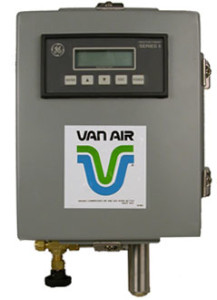Compressed Air Dew Point Monitors – Van Air
 A compressed air dew point monitor from Van Air will indicate if excessive moisture content is present in the compressed air or not. Van Air’s dew point monitors have built a reputation for reliability. Digital compressed air dew point monitors are available for both refrigerated compressed air dryers and compressed air desiccant dryer systems.
A compressed air dew point monitor from Van Air will indicate if excessive moisture content is present in the compressed air or not. Van Air’s dew point monitors have built a reputation for reliability. Digital compressed air dew point monitors are available for both refrigerated compressed air dryers and compressed air desiccant dryer systems.
Monitoring excessive moisture in compressed air lines is important because:
- Excessive moisture in compressed air lines corrodes pneumatic equipment and system piping, normally the most expensive component of a compressed air system.
- Moisture also contaminates sensitive instruments and processes, leading to preventable and costly downtime.
Benefits of using Van Air’s compressed air dew point monitors
- Van Air dew point monitors verify the performance of air dryers by analyzing the water vapor content of compressed air. In the event of an elevated moisture level, Van Air dew point monitors quickly alert plant personnel to minimize maintenance expenses.
- Van Air offers three dew point monitors, suiting a wide range of applications and these units directly measure moisture or dew point at line pressure to reduce errors when converting from atmospheric values to pressure values.
- Van Air dew point monitors are housed in NEMA 4 fiber glass or steel enclosures and arrive in convenient-to-install packages, requiring only power supply and air sample connections.
- All Van Air dew point monitors have a sensor element designed for installation directly within the air line. As a result, the need for complex sample systems, including extensive piping, manifolds, flow and pressure regulators, is eliminated.
- Van Air’s new and existing dew point monitors are available with High Humidity alarms for alarming above 0°F dew points.
Why you should buy a Van Air compressed air dew point monitor from AVP?
- AVP has 25+ years of experience in selection of compressed air dew point monitors in all types of applications, including Compressed Air, Hydrogen, Argon, Natural Gas and many other gases.
- AVP can answer questions and quote prices quickly, same day in most cases.
- Call 866.660.0208 today or chat with us right now!
High Dew Point Indicator – Van Air part number 46-2064
The Van Air High Dew Point Indicator produces an alarm signal when a dew point rises above approximately 0ºF.
A sample of compressed air is passed over a sensor within a sample cell. The resistance of the sensor varies in inverse proportion to the relative humidity to which it is exposed. When the relative humidity rises above the set point, the control activates a relay.
When the relay is closed a “High Dew Point” light is illuminated. The alarm contacts can be used to activate a remote device in the event of elevated air line humidity.
Dew Point Monitor – Van Air part number 46-2529
The Van Air dew point monitor part number 46-2529 measures dew points from -40º to +15ºF (-40º to +59ºC) and comes equipped with three alarm contacts.
The 46-2529 offers an adjustable alarm point and also has a digital readout for convenient direct monitoring. The unit is also equipped with 4-20 mA or 0-5 VDC outputs for continuous monitoring and recording of system performance. This dew point monitor is an economical solution for monitoring performance of regenerative desiccant or membrane dryers.
Dew Point Monitor – Van Air part number 81-1186
The Van Air dew point monitor part number 81-1186 measures dew points from -112ºF to 68ºF (-80ºC to +20ºF) and comes equipped with two standard alarm relays, one fault alarm relay, and a 4-20 mA or 0-5 VDC output for continuous monitoring and recording of system performance. Its alarm point is adjustable to suit the application. The 81-1186 also has a digital dew point readout for convenient direct monitoring.
The 81-1186 is well suited for monitoring the performance of regenerative desiccant compressed air dryers in applications where extremely dry air is required and precise dew point measurements over a wide range are required.